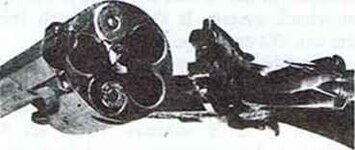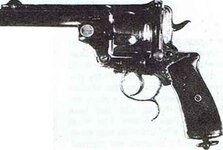Navigation
Install the NWFA app
How to install the app on iOS
Follow along with the video below to see how to install our site as a web app on your home screen.
Note: This feature may not be available in some browsers.
More Options
You are using an outdated browser
The browser you are using is likely incompatible with our website. We recommend upgrading your current browser or installing an alternative.
JavaScript is disabled
Our website requires JavaScript to function properly. For a better experience, please enable JavaScript in your browser settings before proceeding.
-
Join the #1 community for gun owners of the Northwest
We believe the 2nd Amendment is best defended through grass-roots organization, education, and advocacy centered around individual gun owners. It is our mission to encourage, organize, and support these efforts throughout Oregon, Washington, Idaho, Montana, and Wyoming.Free Membership Benefits
- Fewer banner ads
- Buy, sell, and trade in our classified section
- Discuss firearms and all aspects of firearm ownership
- Join others in organizing against anti-gun legislation
- Find nearby gun shops, ranges, training, and other resources
- Discover free outdoor shooting areas
- Stay up to date on firearm-related events
- Share photos and video with other members
- ...and much more!
calibar 577 auguste francotte
- Thread Starter jobelo
- Start date
- Messages
- 9,364
- Reactions
- 23,647
- Messages
- 2,858
- Reactions
- 4,116
Welcome. I don't know which revolver you are talking about. Is it a pinfire?
Looks like a copy of the Bland-Pryse Stopping Revolver.
.577 Caliber Bland-Pryse Stopping Revolver
.577 Caliber Bland-Pryse Stopping Revolver
- Messages
- 9,364
- Reactions
- 23,647
Mae'n ddrwg gen i, dydw i ddim yn siarad Sbaeneg. 
Gold Supporter
Bronze Supporter
- Messages
- 24,874
- Reactions
- 59,177
Looks like a Tranter.
- Messages
- 9,364
- Reactions
- 23,647
Real Handcannon
Last Updated on Sun, 12 Jun 2016 | Firearms Assembly
(r.) The .577/.600 Froncotte revolver. (Below) Cylinder with .577 and .45 ACP cartridges in chambers

(r.) The .577/.600 Froncotte revolver. (Below) Cylinder with .577 and .45 ACP cartridges in chambers

The 'thing' was a Ç-shot revolver hardly bigger than a 1917 Colt New Service. It tipped the scales at 43 ozs. and was of hinged frame construction. Engraved on its barrel rib was the inscription "A. Francotte à Liège", and the figure ".577" was stamped on the left side.
Examination showed that there was nothing about the gun that was .577". The finely rifled 7-groove barrel showed bore diameter .600" and groove diameter .620". Those familiar with English cartridges can clear this one up right away. .577 does not represent the caliber but rather the basic cartridge case used. This pistol fired a cartridge whose case was cut down from a .577 Snider or .577/ .450 Martini-Henry rifle cartridge. A more complété caliber designation, in keeping with English convention, would be ".577/.600 Pistol".
Information on the gun was very courteously supplied by its maker, Auguste Francotte. a Belgian gunmaker long famous for his high-grade double-barrel shotguns. Revolvers of this design were made in .320. .380. .450. and .500 calibers and "occasionally also in .577 caliber". They were manufactured about 1892 under the patent of Phillip Counet (gun so marked), a Francotte employee whose patent covered the ice-tong-like frame lock. It was stated that the .577 caliber was "popular with the police and pioneers going to distant colonies".
It is believed that the following will amplify this picture. In the early 1890's England undertook the task of conquering the Egyptian Sudan, which was defended by tribes under the leadership of wild dervishes. Demand arose amongst the British officers for a handgun with real stopping power to halt the fanatical onslaughts of the sword-swinging natives. Our mystery magnum may have resulted, directly or indirectly, from that requirement. Recently the author had the opportunity to examine another revolver of this caliber, a solid-frame clover-leaf cylinder job made by Tranter of England —which perhaps adds some weight to this idea.
For reloading the gun at hand, brass was cut from some solid head .577 Snider rifle cartridges. A bullet mold was made up for a Keith-type bullet, which had to be generously hollow-based to keep its weight within reason. Even so. the finished product, lubricated and sized to .619", pulled down the balance pan to 535 grs.
Being in the dark at first as to the factory loadings of the .577 pistol cartridge. I started with 25 grs. of Fg blackpowder. The general high class of workmanship of the weapon and the inscription "Acier Fondu" (forged steel) appearing on its barrel were reassuring. A load of 45 grs. of half-and-half FFg and Fg. about all the cartridge would take, appeared to be maximum and safe—not only for the gun but also for the guv behind it. I found later from the Kvnoch ballistic tables that the original factory .577 pistol cartridge had a 450-gr. lead bullet ahead of 28 grs. of blackpowder. a load with a muzzle velocity of 725 f.p.s. and a muzzle energv of 525 ft. lbs. On that basis I would estimate a muzzle velocity of 800 f.p.s.. which would give a muzzle energv of 760 ft. lbs.
Accuracy was found quite good, in spite of the fact that the gun had to be aimed quite low to compensate for the terrific jump. With the 40-gr. load, several palm-size groups were obtained at 45 ft. using the original sights 3nd holding 26" low.
Smokeless loadings were also experimented with, and about 11 grs. of #6 appeared to be a maximum safe load. Thiese smokeless loadings were abandoned however, when it was discovered that they had a dangerous tendency to blow out their bullet noses and leave a lead sleeve in the bore.
I have been asked at various times to describe what it is like to touch off one of those 40-gr. blackpowder loads in the 'magnum'. This is not easy to do. About all I can say is that it is spectacular and unforgettable. The thing erupts with a terrific boom, flash, and clouds of thick smoke, followed by a powerful arm stroke upward.—F. Von Muller.
Last Updated on Sun, 12 Jun 2016 | Firearms Assembly
(r.) The .577/.600 Froncotte revolver. (Below) Cylinder with .577 and .45 ACP cartridges in chambers

(r.) The .577/.600 Froncotte revolver. (Below) Cylinder with .577 and .45 ACP cartridges in chambers

The 'thing' was a Ç-shot revolver hardly bigger than a 1917 Colt New Service. It tipped the scales at 43 ozs. and was of hinged frame construction. Engraved on its barrel rib was the inscription "A. Francotte à Liège", and the figure ".577" was stamped on the left side.
Examination showed that there was nothing about the gun that was .577". The finely rifled 7-groove barrel showed bore diameter .600" and groove diameter .620". Those familiar with English cartridges can clear this one up right away. .577 does not represent the caliber but rather the basic cartridge case used. This pistol fired a cartridge whose case was cut down from a .577 Snider or .577/ .450 Martini-Henry rifle cartridge. A more complété caliber designation, in keeping with English convention, would be ".577/.600 Pistol".
Information on the gun was very courteously supplied by its maker, Auguste Francotte. a Belgian gunmaker long famous for his high-grade double-barrel shotguns. Revolvers of this design were made in .320. .380. .450. and .500 calibers and "occasionally also in .577 caliber". They were manufactured about 1892 under the patent of Phillip Counet (gun so marked), a Francotte employee whose patent covered the ice-tong-like frame lock. It was stated that the .577 caliber was "popular with the police and pioneers going to distant colonies".
It is believed that the following will amplify this picture. In the early 1890's England undertook the task of conquering the Egyptian Sudan, which was defended by tribes under the leadership of wild dervishes. Demand arose amongst the British officers for a handgun with real stopping power to halt the fanatical onslaughts of the sword-swinging natives. Our mystery magnum may have resulted, directly or indirectly, from that requirement. Recently the author had the opportunity to examine another revolver of this caliber, a solid-frame clover-leaf cylinder job made by Tranter of England —which perhaps adds some weight to this idea.
For reloading the gun at hand, brass was cut from some solid head .577 Snider rifle cartridges. A bullet mold was made up for a Keith-type bullet, which had to be generously hollow-based to keep its weight within reason. Even so. the finished product, lubricated and sized to .619", pulled down the balance pan to 535 grs.
Being in the dark at first as to the factory loadings of the .577 pistol cartridge. I started with 25 grs. of Fg blackpowder. The general high class of workmanship of the weapon and the inscription "Acier Fondu" (forged steel) appearing on its barrel were reassuring. A load of 45 grs. of half-and-half FFg and Fg. about all the cartridge would take, appeared to be maximum and safe—not only for the gun but also for the guv behind it. I found later from the Kvnoch ballistic tables that the original factory .577 pistol cartridge had a 450-gr. lead bullet ahead of 28 grs. of blackpowder. a load with a muzzle velocity of 725 f.p.s. and a muzzle energv of 525 ft. lbs. On that basis I would estimate a muzzle velocity of 800 f.p.s.. which would give a muzzle energv of 760 ft. lbs.
Accuracy was found quite good, in spite of the fact that the gun had to be aimed quite low to compensate for the terrific jump. With the 40-gr. load, several palm-size groups were obtained at 45 ft. using the original sights 3nd holding 26" low.
Smokeless loadings were also experimented with, and about 11 grs. of #6 appeared to be a maximum safe load. Thiese smokeless loadings were abandoned however, when it was discovered that they had a dangerous tendency to blow out their bullet noses and leave a lead sleeve in the bore.
I have been asked at various times to describe what it is like to touch off one of those 40-gr. blackpowder loads in the 'magnum'. This is not easy to do. About all I can say is that it is spectacular and unforgettable. The thing erupts with a terrific boom, flash, and clouds of thick smoke, followed by a powerful arm stroke upward.—F. Von Muller.
- Messages
- 1
- Reactions
- 0
the creator of this caliber was counet in about 1870 ... then for economic reasons he sold the patent to auguste francotte, this revolver is from 1880 created by one of the best gunsmiths in the world ... I don't know its price but it must be fairly tall.
Share This Discussion
Similar threads
Upcoming Events
New Classified Ads
-
-
WTS/WTT Midwest 30MM QD SCOPE MOUNT for Midwest 34MM QD SCOPE MOUNT
- Started by Rixotic
- Replies: 0
-
-
16" complete AR upper with quad rail
- Started by whutdidyousay
- Replies: 0
-
-
-
Leupold vari-x II 3-9x40 gloss
- Started by urbanimports02
- Replies: 0
-
-
-
Winchester m23 pigeon grade XTR lightweight 3in 12 gauge
- Started by alelord
- Replies: 0
Support Our Community
If our Supporting Vendors don't have what you're looking for, use these links before making a purchase and we will receive a small percentage of the sale













